Let the Oil Flow: A Beginner's Guide to Fountain Pens (Anatomy, Practice, and Purchasing)
George Carlin once joked that when you get to Heaven, you get back everything you ever lost. By Carlin’s impression (NSFW), Saint Peter or whoever else would greet him at the pearly gates with every item he’d misplaced:
“Here you are: seventy-nine pairs of sunglasses, two hundred and twelve cigarette lighters, four thousand nine hundred and eighty-three ballpoint pens.”
By his own account, Carlin was a prolific note-taker—in one of his final interviews, he described himself as “a writer who performs his own material.” That’s one reason for the high number of lost pens, but of course, he was also poking fun at the crappiness and disposability of a typical ballpoint pen. It’s the kind of thing you never keep.
There are two problems with cheap ballpoint pens: (1) they’re crappy pens and (2) they’re everywhere.
They’re built to be uniform, disposable, mess-free, and dirt-cheap—and by this design, it’s near-impossible for them to be quality writing instruments too. Yet, because they’re ubiquitous, we’ve gotten used to them, and our handwritten work has suffered. Kids nowadays go straight from crayons and markers to No. 2 pencils and Bic ballpoints (hell, we did that).
But what’s the alternative?
Investing in an old-timey inkwell and feather quill? Spending hundreds of dollars on a fragile-looking, oddly-shaped fountain pen?
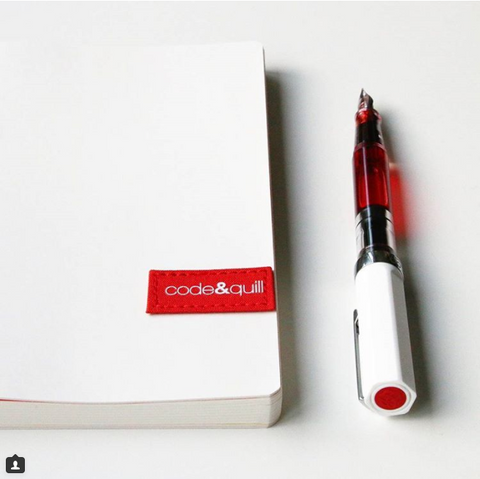
Photo Credit: @norwegianplanner
Nay. What if we told you that a $40 investment could permanently change how much you love writing by hand? Even more—what if we told you that using a fountain pen could save you money over time, and that you might someday consider a $300 pen “totally worth it”?
If you’re happy with by-the-box pens and you never want for more, you can bail out now.
Otherwise, let’s talk about fountain pens.
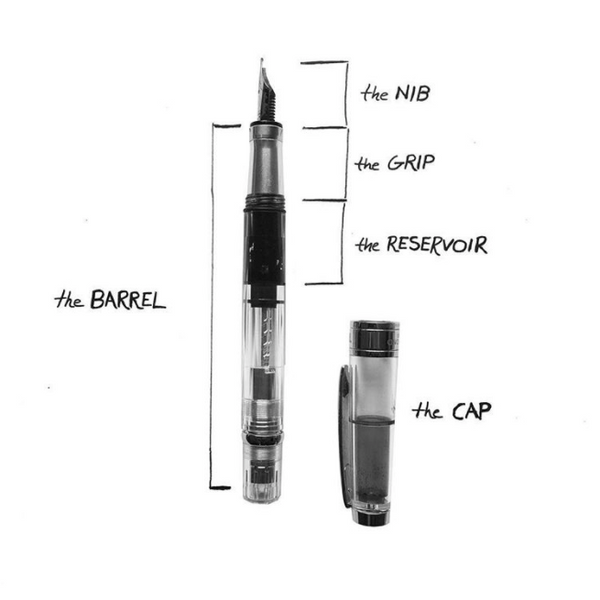
First, an anatomy lesson—a fountain pen’s main parts are:
- the barrel
- the nib
- the ink reservoir
There are other details, too, but we don’t need to cover them in detail here (you’ll learn best with a pen of your own, anyway).
The Barrel
The barrel is the term for the main exterior body of the pen; it’s what you see and hold. Like with cars, for instance, what’s pretty to you, comfortable to you, and suitable for your needs are all matters of taste.
The grip is, of course, the section of the barrel that is most important for comfort in your fingers.
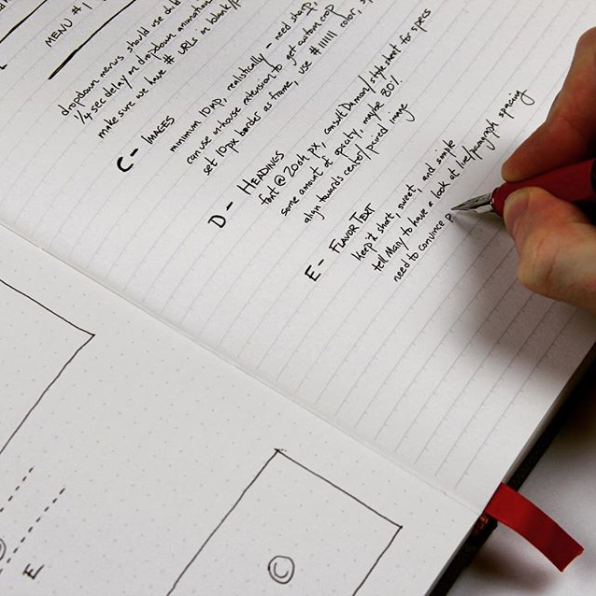
One of the other properties you’ll notice right away, and develop preferences for, is the weight of the pen; some people prefer heft, others want the pen feather-light. A starter pen will likely be lighter.
(NOTE: A pen is nothing without the paper it writes on! Do your pen (and yourself) a favor and check out a Code&Quill notebook—100GSM, acid-free paper, perfect for writing your brilliant ideas on.)
As for barrel size and ergonomics, you may have to just eyeball it, especially if you’re browsing online. However, as long as the pictures, description, and reviews roughly match what you’d want, don’t sweat the decision too much; after all, you need to try one pen before you can compare it with others.
We'll talk about where to buy your first fountain pen a little bit later in this post!
The Nib
The nib is the pointy section of the pen, where the ink comes out, and it’s the nib that makes a fountain pen what it is. This is because the nib controls the precise flow and dispersion of ink—and it’s the part of the pen upon which you apply pressure as its user.
When you apply pressure to the nib correctly, it opens a small channel from the ink reservoir, which is gently pressurized and thus continues to bleed ink for as long as you press down.
The ink begins flowing at a spot near the middle of the nib, then flows along a fine groove towards the tip (visible above).
If the groove is thinner and the tip sharper, less ink will reach the page and you’ll have a finer stroke; if the groove is wider and the tip broader, more ink will reach the page and you’ll have a broader stroke.

Photo Credit: @mnmlscholar
For our purposes, we can simplify nibs to four types:
- extra fine
- fine
- medium
- broad
Most starter pens are offered in a selection like this. Different strokes for different folks, but we recommend fine or extra fine to start, since those are most similar in ink flow to the pens you already use.
Nibs are also the principal source of a fountain pen’s sophistication; steel works perfectly fine for starter pens, but some of the most refined (and bougier) pens have iridium-tipped or gold nibs. Hence, the very large price tags on some fountain pens.
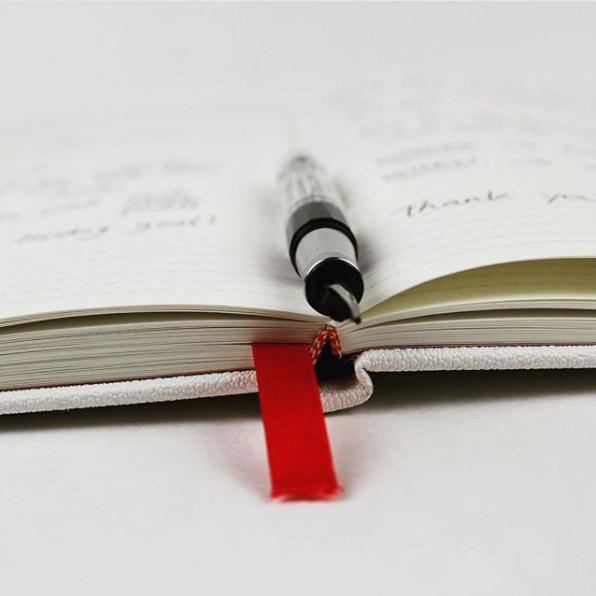
Aside from being functionally different, in terms of the way they deliver ink to the page, fountain pens also feel different because of their nibs.
Unlike a typical pen, you can’t hold a fountain pen at any angle or use any amount of pressure. The nib only opens in one direction, and it’s much more pressure-sensitive; too little pressure and no ink comes out, but too much and it flows generously, and you feel yourself scratching the pages harshly.
You become distinctly aware of the slight give to the nib, the way it bends gently under pressure—and once you’ve gotten into rhythm, it feels good. You’re more conscious of what you’re doing, your strokes look better, and you get the sense that you’re cutting grooves in meaning just as much as you are putting ink on a page.
Put simply, it’s this tactile experience that makes fountain pens worth the fuss.
To raise an argument we’ve made before: you can justify $40 (or more, depending) for a fountain pen when it’s something that improves your experience and quality of expression while performing your essential working, thinking, and creative functions.
The Ink Reservoir
We use the general term “reservoir” because there are a few different ways fountain pens can hold ink. For most starter pens, you won’t have to deal with ink manually, since they often use disposable cartridges which mostly take care of themselves. In many cases, the cartridges are proprietary to that model of pen, but you can also purchase converters which enable the cartridges you have to be refilled with other ink.

Photo Credit: @mnmlscholar
In other cases, the pen will have its own permanent reservoir which has to be refilled.
Admittedly, this is a disadvantage to fountain pens: you have to deal with ink. Fortunately, many fountain pen designers are quite clever with the mechanisms of ink flow. In the TWSBI 580AL, for instance—pictured below on the left and elsewhere in this article—there’s a twist action at the bottom of the pen that causes a vacuum-sealed chamber to draw or expel, like a syringe, allowing you to “suck up” ink come time to refill.
Sure, it’s a little messy to have to deal with ink.
But once you notice the tactile difference of a fountain pen, you’ll notice the inks are more impressive, too. You can buy all different sorts, including some crazy stuff like invisible ink and scented ink; you can choose from broader and richer colors and with any number of properties you prefer.
As you’re getting started, just stick with the cartridges—but know that this is what you can work up to if you enjoy the difference.
Where to Start
There are a number of fountain pens available for $40 or less, but one standout is the Lamy Safari (starting around $23 on Amazon). It’s perfect for newbies—it’s simple, it comes in a variety of colors, it has replaceable cartridges, and most importantly, it works well (hence its recommendation from Reddit). We’ve been happy using them at our desks every day in the Code&Quill office.
If you wanted some other options for comparison, consider a look at...
- Platinum Preppy ($7 on Amazon)
- Pilot Metropolitan (around $18 here)
- Kaweco Classic Sport (around $26 here)
- TWSBI 580 (around $50 here)
If you'd like a good place to buy fountain pens and any of the extra gear you might want, check out Goulet Pen Company. They've got everything you need to get started, from the equipment to the know-how and quality customer service.
Why Bother?
At Code&Quill, we’re big believers in investing in your gear. Just as the fashionable invest their spare money in clothes—in quality garments that fit their styles and personalities—we like spending our spare money on quality tools, toys, and equipment.
By the way, if you’re still skeptical about spending $40 on a pen, scroll to the Addendum where we lay out how fountain pens aren’t such a splurge in the long run.
We’ll skimp on other things, but we’ll spend $30 or more on a pen.
We’ll spend $20 on a sturdy, dark, handsome hardcover notebook or its lily-white companion.
A shameless plug, sure, but in fairness, we were spending that amount on notebooks long before Code&Quill started, for the simple reason that we valued our notebooks as more than sums of paper.
We wanted them to be good notebooks. The pages of a good notebook aren’t like other pages; they’re not suited for endless schoolhouse repetition or fueling the copy machine. The notebook, at its best, holds more than notes; it holds complete thoughts, ideas, and impressions.
The pen, at its best, does more than deliver ink; it helps you find what you’re trying to write.
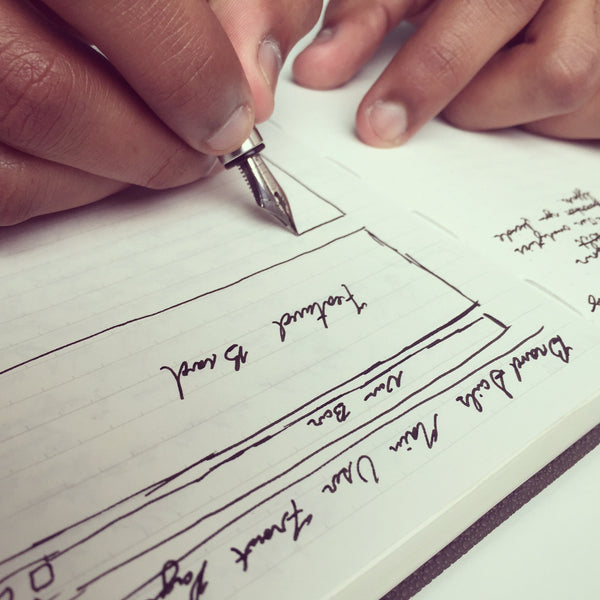
So if it’s true that in Heaven you get back everything you ever lost, we’ll each have a shoebox or two of cheap writing utensils from our younger years. But if Saint Peter or whoever else asks why so few, and not the thousands of Bics he usually gives back, we’ll just grin, reach into our pockets, and each produce a weathered barrel with a funny-looking point.
Addendum: Cost Economics of Fountain Pens
There’s just one last matter to tie up: can you really justify $30 or $40, or more, on a single pen?
Let’s do a little bit of math. Before switching over to fountain pens, we favored rollerballs like the Pilot Precise V5, which run about $20 per dozen. Let’s assume that your standards are at least high enough that you don’t enjoy using the cheapest ballpoints, and that you might therefore spend a similar amount per pen—a dollar and change each.
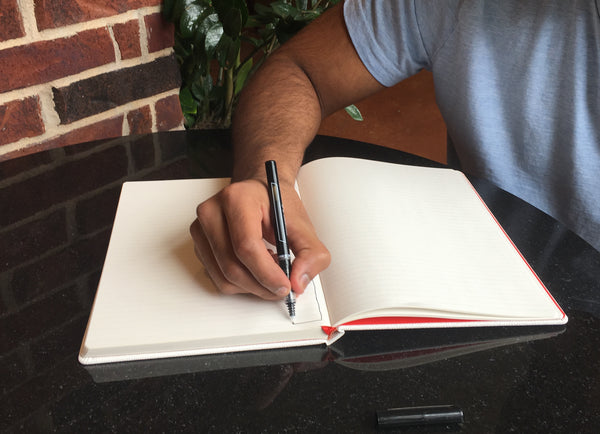
Assume further that you’re a student, a professional, a creative person, or some combination. You could easily finish a box of a dozen pens every six months, or roughly one pen every two weeks—given normal use, breakages, and loss.
That’s two dozen pens per year, or $40+ per year in our case.
Probably you see our point already. With the same money, you can get a quality fountain pen and some extra ink, and you’ll be enjoying yourself more with every letter you write.
Meanwhile, with virtually any disposable pen, even a nicer one like the Precise V5, it will write okay until it inevitably breaks and leaks, or until the nib somehow gets screwed up. (Again, it’s difficult to imagine designing a pen that’s both disposable and ideal for writing. They seem at odds.)
The following year, with your annual “pen budget,” you can buy a second pen, some more ink, and maybe an extra nib or two. At this point, you don’t really need pens anymore. You’re set indefinitely; anything you choose to buy is just ink refills or a hobby purchase.
(Meanwhile, of course, you’ve been having way more fun than the other chumps.)
Of course, this makes one crucial assumption: that you won’t lose or abuse your fountain pen.
That might seem like a bad assumption, given how we treat other writing instruments. But, actually, that’s precisely the point: we treat disposable items disposably and personal items personally.
When you buy your pen, it becomes one of your tools, one of your personal effects. You might be surprised at how strongly you identify with it, and how you suddenly treat it with greater respect. Accidents still happen, sure—but you won’t be throwing your pen around, you won’t be idly leaving it places, and if you lend it to someone, you definitely won’t let it leave your sight.
Ready to take the plunge? We'd have a hard time believing you'd be sorry if you invested in one of these quality writing tools, but we'd love to hear about your experience in the comments!
(NOTE: A pen is nothing without the paper it writes on! Do your pen (and yourself) a favor and check out a Code&Quill notebook—100GSM, acid-free paper, perfect for writing your brilliant ideas on.)





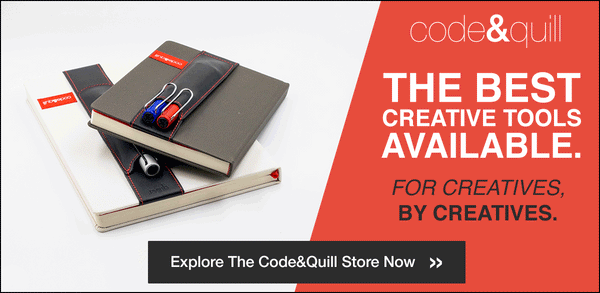

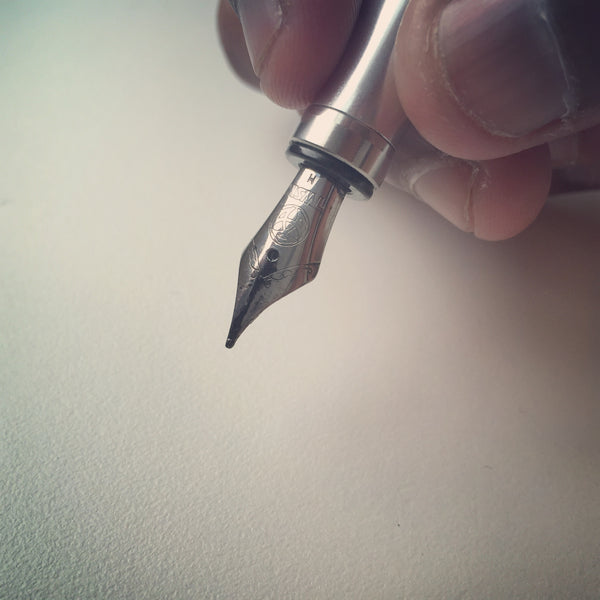

tadalafil uses cialis pills tadalafil price at walmart
имя знак зодиака камень
берилл камень знак зодиака
камень знак зодиака рыбы
камень авантюрин знаки зодиака
знаки зодиака какие камни
https://thenewstipa.blogspot.com/2021/05/blog-post.html
https://tarrdirtwormni.tumblr.com/
https://newnewsabout.blogspot.com/2021/05/blog-post.html
знаки зодиака камень стихия
серафинит камень знак зодиака
камни знакам зодиака драгоценные
знак рыба камень зодиака
камни овна знаки зодиака
лев знаки зодиака камни
кахолонг камень знаки зодиака
берилл камень знак зодиака
знак зодиака камни рыбы
камни скорпион знак зодиака
знак зодиака камень аметист
камень соответствует знаку зодиака
камень львов знака зодиака
tadalafil 20mg tablets https://tadalisxs.com/ tadalafil otc
lowest price cialis https://tadagatadalafil.com/ – cialis at canadian pharmacy buy tadalis tadalafil online canada generic tadalafil
lowest price cialis https://tadagatadalafil.com/ – cialis at canadian pharmacy buy tadalis tadalafil online canada generic tadalafil
Leave a comment